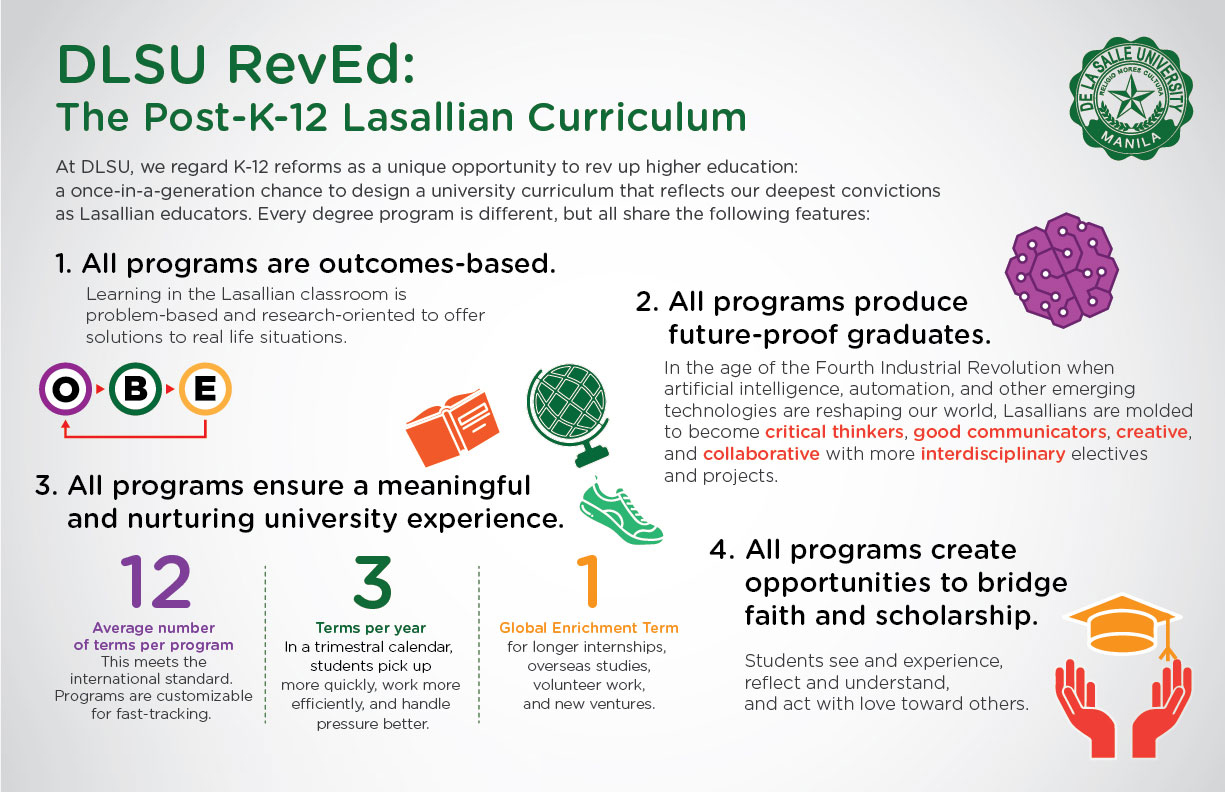K-12 added two years to our basic education cycle, but it also changed higher education. Many of the subjects college students used to take as part of their General Ed have since been moved to Senior High School.

click for larger image
This alone means universities cannot simply offer the same curricula as before.
At DLSU, we regard K-12 reforms as a unique opportunity to reimagine or even reboot higher education: a once-in-a-generation chance to design a university curriculum that reflects our deepest convictions as Lasallian educators.
It’s more challenging than one might think. The cost of education everywhere has more than doubled since the 1990s, and as a result, students, parents, and stakeholders are right to demand more from a university degree. Many understandably prioritize getting a degree as quickly as possible to seize the first job opportunity available. But the research on this is also clear: in the especially demanding labor markets of the 21st century, if one comes out of college with no more than a set of academic credentials, one is taking a potentially costly gamble. Graduating ahead of one’s batch mates may improve job search prospects, but employers are just as likely to believe that one has probably missed out on some important formative experiences.
That’s why we have always thought it shortsighted to treat college as purely a means to find work. Attending university is about maturing: honing critical thinking and writing skills, investing time and effort to develop networks, deepening empathy and citizenship, learning to collaborate well and work within teams. Nowadays, it is also about enlarging a student’s world-view through extra-curricular experiences here and abroad.
We’re told that higher education should produce workplace-ready graduates. Yet we’re also told the workplace is changing in unpredictable ways because of the so-called “Fourth Industrial Revolution” ushered in by robotics, artificial intelligence, and nanotechnology. We will need to educate students for jobs that do not yet exist, as we already inhabit a world in which old jobs are destroyed as quickly as new ones are created.
Universities all over the world are challenged to adopt the sort of teaching and learning methods that will ensure graduates acquire complex problem solving skills. Society now places an even greater burden on universities to produce not just competent, but ethical graduates—graduates who are more dependable because of their extra-curricular involvements, experiences overseas, who have a moral backbone from their time spent in reflection…but who can, of course, also handle stress.
In the 21st century, there is much more to higher education, and universities must respond.
In the 21st century, there is much more to higher education, and universities must respond.
At DLSU, our academic departments have spent the last two years designing our post-K-12 curricula. Every degree program is different, but all share the following features:
a. Our programs adopt an outcomes-based education: We clearly define at the very beginning what students will know, will be able to do, and will value by the end of their study, then use these target outcomes as the basis for developing course requirements and learning activities. Learning in the Lasallian classroom is problem-based and research-oriented. We match a student’s desire to learn actively with our faculty’s vocation to mentor wholeheartedly;
b. Our programs prepare students for the Fourth Industrial Revolution: we prioritize critical thinking, communication, creativity, and collaboration. These programs are inter-disciplinary by design. In the jargon of higher education, multidisciplinary learning brings various perspectives together to shed light on a matter, but inter-disciplinary learning goes further, producing coherent analyses and solutions that go beyond narrow disciplinal boundaries. Engineers must be able to work within environmental and regulatory constraints, business owners must be able to use the large datasets now available to formulate strategies, software developers must be able to explore cultural resources to develop intuitive apps and immersive games.
In a volatile, uncertain, complex, and ambiguous (VUCA) world, our graduates will need to go further than mere acquaintance with different perspectives: they’ll need full engagement and real practical problem-solving experiences with peers from different disciplines. We have responded by increasing the number of available interdisciplinary electives and projects, creating more opportunities to minor, and making courses more modular so students can take advantage of the intellectual diversity within our 36 academic departments;
c. Our programs create a meaningful and nurturing university experience: they still run 12 terms on average, to enable our students to properly balance curricular and extra-curricular work under a trimestral system. With a new Global Enrichment Term in place, students can decide to do longer internships that many companies encourage, study overseas, do volunteer work and community engagement, or even start ventures.
DLSU will still follow a trimestral system. Employers have long noted that DLSU graduates are able to pick up more quickly, work more efficiently, and handle pressure better. The pace of the trimestral system has helped to forge these advantages. So as before, it will still be possible to graduate earlier, for those inclined. The 12-term average meets the international standard of 16 years to a bachelor’s degree, but with customizable and flexible options, including fast-tracking, to accommodate different student priorities;
Most of all,
d. Our programs provide numerous curricular and extra-curricular opportunities for students to learn how to bridge faith and scholarship: to see and experience, reflect and understand, then fulfill by acting with love toward others.
These are our commitments to the post-K-12 university student: degree programs that are modern, future-proof, and rooted in the best traditions of Lasallian education.
